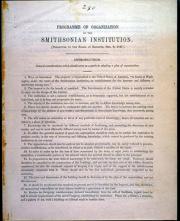An Institution Emerges
Joseph Henry - First Smithsonian Secretary, 1846-1878
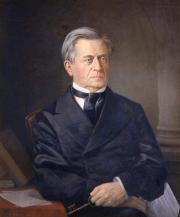 "A new impulse will thus be given to investigation in every department of science; and learned men will know that through you they will be able to make their discoveries available to their brethren throughout the civilized world." —Letter from Francis Wayland to Secretary Joseph Henry, December 19, 1848
"A new impulse will thus be given to investigation in every department of science; and learned men will know that through you they will be able to make their discoveries available to their brethren throughout the civilized world." —Letter from Francis Wayland to Secretary Joseph Henry, December 19, 1848
Perhaps the country's best known physicist and a well-respected figure in European as well as American scientific circles, Joseph Henry (1797-1878) became the Smithsonian's first Secretary, or chief executive, in 1846. Henry's vision for the Smithsonian centered around his interpretation of Smithson's will as a call for a scientific research establishment.
Many Americans viewed the Regents' selection of Joseph Henry from the long list of candidates as a triumph of merit over political favoritism. Respected not only as one of the young country's few major scientists, Henry also had a reputation for personal integrity. Supported by fellow scientist and Smithsonian Regent Alexander Dallas Bache, Henry strove to develop the Smithsonian into the nation's first major research institute for science.
During Secretary Henry's tenure, the Smithsonian gained widespread acclaim not only as the country's foremost scientific research institute but also as a facilitator of international scientific dialogue. Congressionally-mandated programs for the public kept Americans informed about Smithsonian activities.
The Henry Years
Advocate for American Science
"The Smithsonian Institution is . . . opening new fields of philosophical research, increasing the amount of knowledge not only in the United States, but in all civilized nations, and commanding a name and respect every where; thus reflecting honor upon our country." —National Intelligencer, November 5, 1852
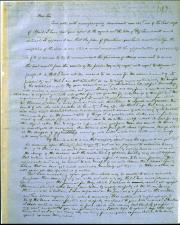 Whereas some Americans accused Secretary Henry of squandering Smithson's bequest on the risky and elitist venture of scientific research, many others hailed him as a visionary.
Whereas some Americans accused Secretary Henry of squandering Smithson's bequest on the risky and elitist venture of scientific research, many others hailed him as a visionary.
"[The Smithsonian] must, it will become a fountain from which ten thousand streams will flow out in all directions to refresh and gladden the hearts of all who will partake its bounty." —Letter from William Bacon, a farmer, to Secretary Joseph Henry, June 4, 1849
"Under [Secretary Henry's] auspices, we have a sufficient guaranty that charlatanism and pretension, in all forms, will be held aloof, while science and sound learning, with the true spirit of investigation, will be fostered to the utmost." —Benjamin Silliman, Sr., professor at Yale College, American Journal of Science and Arts, 1847
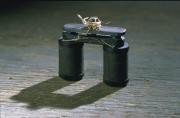 Secretary Henry expressed keen awareness of special difficulties faced by his fellow American scientists in exchanging scientific dialogue and publications with scientists elsewhere. He maintained that James Smithson's mandate called for an organization to promote original scientific research and to foster international scientific communication.
Secretary Henry expressed keen awareness of special difficulties faced by his fellow American scientists in exchanging scientific dialogue and publications with scientists elsewhere. He maintained that James Smithson's mandate called for an organization to promote original scientific research and to foster international scientific communication.
As a scientist, Joseph Henry was recognized for his discovery of principles essential to the development of the long-distance telegraph, the electric motor, and the transformer.
Guardian of the Smithson Bequest
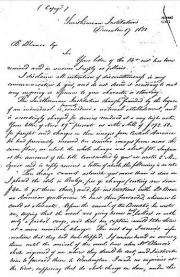 Secretary Henry personally negotiated with a number of commercial enterprises—international couriers in particular—to donate their services to the Smithsonian. He maintained close oversight to ensure that agreements were met and costs contained.
Secretary Henry personally negotiated with a number of commercial enterprises—international couriers in particular—to donate their services to the Smithsonian. He maintained close oversight to ensure that agreements were met and costs contained.
In this instance, Secretary Henry conveyed to B. Blanco his displeasure in having a shipping firm charge $192.50. He indicated that accepting the charge would have constituted "an improper expenditure of money left for a benevolent purpose."
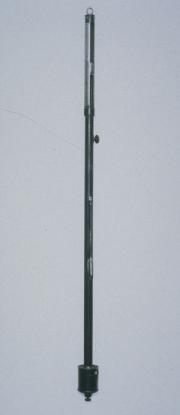 Forerunner of the U.S. Weather Bureau
Forerunner of the U.S. Weather Bureau
Determined that the Smithsonian should become a center for scientific activity, Secretary Henry in 1848 established a national volunteer meteorological network in cooperation with the federal government and the telegraph industry. Scientists working in the Smithsonian Building used incoming data to track storms and to construct a daily weather map.
Educating the People of Washington
Public Opportunities

Public lectures were a regular part of early Smithsonian activities as a result of Congress' insistence on public access to the Smithsonian. The Smithsonian Building originally had one of Washington's largest public lecture halls. Secretary Henry discontinued the lectures after a fire in the Smithsonian Building in 1865 destroyed the lecture hall.

The Apparatus Room
Part exhibit gallery, part product demonstration facility, the Apparatus Room, which Secretary Henry opened in 1854, captured the interest of Smithsonian researchers and visitors alike.
"To Stimulate the Talent of Our Country"
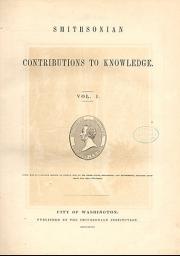
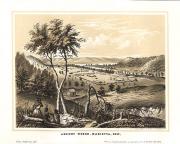 Smithsonian Contributions to Knowledge
Smithsonian Contributions to Knowledge
Through funding the research report series Smithsonian Contributions to Knowledge, Secretary Henry aimed to overcome what he considered one of the greatest obstacles to American science: the high cost of scientific publication. The series' first volume, Ancient Monuments of the Mississippi Valley, was a landmark American archaeological monograph. Smithsonian Contributions to Knowledge is still published today and distributed free of charge to research institutions and scholars.
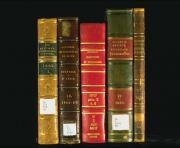 International Exchange Service
International Exchange Service
To keep the high cost of transatlantic transportation from hampering the work of American scientists, Secretary Henry in 1850 set up a low-cost system for international exchange of scholarly publications. The International Exchange Service enhanced the reputations of both American science and the Smithsonian for nearly 150 years. The service played an important role in shaping the Smithsonian Institution Libraries' collections.
"A Library Quite Unique"

Although interested in maintaining a scientific library, Secretary Henry believed that turning the Smithsonian into a national library would cripple its other activities. In 1866, he moved most of the Smithsonian's 40,000-volume library to the Library of Congress, where it became known as the "Smithsonian Deposit."
Secretary Henry endorsed the compilation and publication of the first national listing of library resources as part of the Smithsonian's efforts to gather national statistics.

